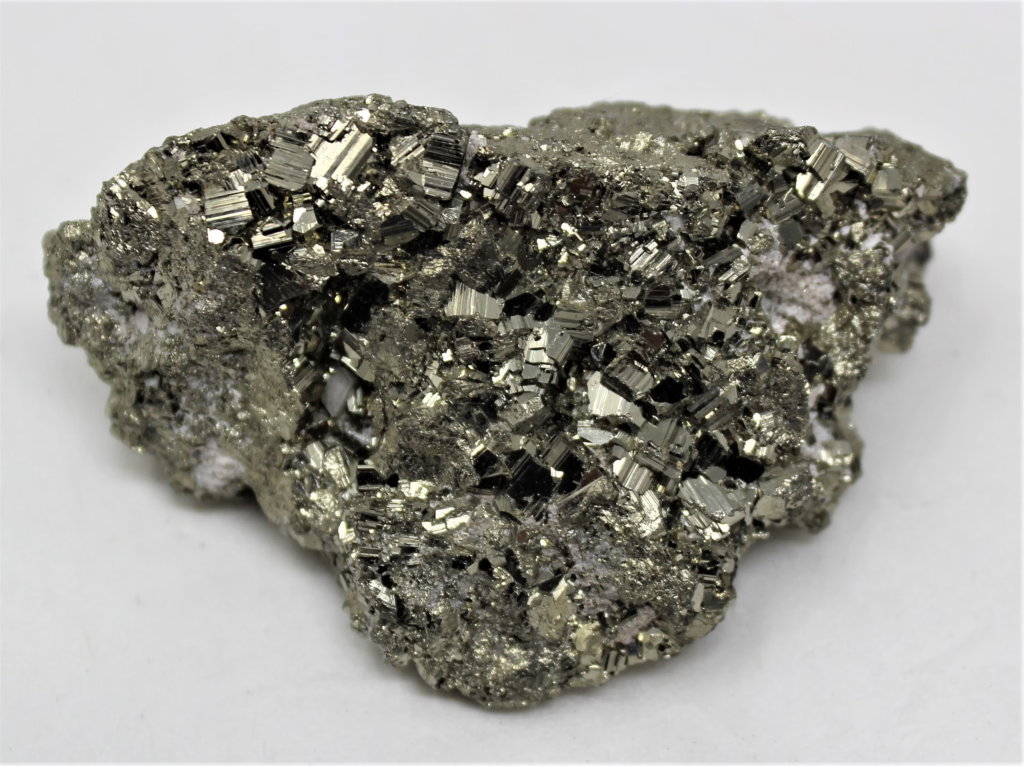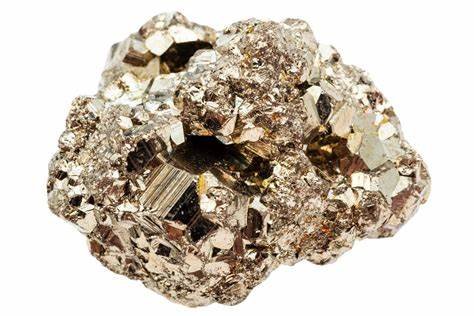Pyrite, often referred to as “fool’s gold” due to its striking resemblance to the precious metal, is a fascinating mineral with a rich history and diverse applications. While its name might evoke disappointment for those hoping for a gold strike, pyrite offers a unique blend of beauty, scientific intrigue, and practical uses.
What is Pyrite?
It crystallizes in the isometric crystal system, often forming beautiful cubic, octahedral, or pyritohedral crystals. Pyrite is known for its characteristic brassy-yellow color and its metallic luster, which can easily fool the untrained eye into mistaking it for gold.
Formation and Occurrence
Pyrite is a widespread mineral, forming in a variety of geological environments. Some of the common formation processes include:
Sedimentation: Pyrite forms in sedimentary rocks, such as shales and sandstones, during the deposition of organic-rich sediments.
Hydrothermal Activity: It can also form in hydrothermal veins, where hot, mineral-rich fluids circulate through rocks.
Metamorphism: Pyrite can be formed during the process of metamorphism, where rocks are subjected to high temperatures and pressures.
Physical and Chemical Properties
Color: Brassy-yellow
Luster: Metallic
Hardness: 6-6.5 on the Mohs scale
Streak: Greenish-black
Cleavage: Poor
Fracture: Uneven
Specific Gravity: 4.9-5.2
Pyrite is relatively brittle and can be easily scratched with a steel file. It is also known for its characteristic “pyritic odor” – a strong, sulfurous smell released when it is struck or scratched.
Why is Pyrite Called “Fool’s Gold”?
The nickname “fool’s gold” is a testament to pyrite’s deceptive appearance. Its bright, metallic luster and brassy-yellow color can easily mislead prospectors and casual observers into believing they have stumbled upon a gold vein. However, pyrite is significantly harder than gold and lacks the malleability and ductility characteristic of the precious metal.
Uses of Pyrite
Despite its inability to enrich one’s fortune, pyrite has a variety of uses:
Ore of Iron and Sulfur: Pyrite is an important source of iron and sulfur. It is mined and processed to extract these elements, which are used in various industries.
Jewelry and Ornamental Purposes: Due to its attractive appearance, pyrite is often used in jewelry making, particularly for inexpensive costume jewelry. It is also used in decorative objects and carvings.
Scientific Research: Pyrite plays a significant role in scientific research. It is used as a source of sulfur for the production of sulfuric acid, a crucial industrial chemical.
Geochemical Indicator: The presence of pyrite in rocks can provide valuable information about the geological history and environment of formation.

Pyrite and Human Health
While generally harmless, pyrite can pose some health risks:
Respiratory Issues: Inhalation of pyrite dust can irritate the respiratory system, causing coughing, shortness of breath, and other respiratory problems.
Acid Mine Drainage: Pyrite oxidation in mines can lead to the formation of acidic water, which can contaminate nearby water sources and harm aquatic life.
Interesting Facts about Pyrite
“Striking Fire”: Pyrite is known for its ability to produce sparks when struck against steel. This property was utilized in early firearms and was a significant technological advancement in its time.
“Inca Gold”: In ancient Peru, pyrite was often used to create elaborate and intricate gold-like ornaments and decorations.
Pyrite Cubes: Pyrite often forms perfect cubic crystals, making it a popular specimen for mineral collectors.
Pyrite in Popular Culture
Pyrite often referred has made its mark in popular culture, appearing in various forms:
Literature: Pyrite has been mentioned in numerous literary works, often as a symbol of false hope or deceptive appearances.
Art: Artists have long been fascinated by pyrite’s striking appearance and have incorporated it into their works.
Music: Pyrite has inspired songs and lyrics, often reflecting its association with wealth, deception, and the allure of the unknown.
Varieties and Associated Minerals
Marcasite: A closely related iron sulfide mineral with a similar chemical composition but different crystal structure. Marcasite crystals are typically more slender and elongated than pyrite.
Pyrrhotite: Another iron sulfide mineral that can be associated with pyrite. It typically has a bronze-yellow color and is magnetic.
Chalcopyrite: A copper iron sulfide mineral often found in association with pyrite. It has a brassy-yellow color with a greenish tinge.
Gold: While not always present, pyrite can sometimes contain microscopic inclusions of gold. This is particularly true in certain types of gold deposits.
Further Exploration
Pyrite in Meteorites: Research the occurrence of pyrite in meteorites and its implications for the study of extraterrestrial environments.
Pyrite and Acid Mine Drainage: Investigate the mechanisms of pyrite oxidation and its role in the formation of acid mine drainage and the development of remediation strategies.
The Role of Bacteria in Pyrite Formation: Explore the fascinating role of microorganisms in the formation of pyrite in sedimentary environments.
Final Thoughts
Pyrite, often referred though often dismissed as “fool’s gold,” is a fascinating mineral with a rich history and diverse applications. Its striking appearance, intriguing properties, and widespread occurrence make it a subject of ongoing scientific interest and a source of fascination for mineral enthusiasts and the general public alike. While it may not bring the riches of gold, pyrite offers a unique blend of beauty, scientific intrigue, and practical utility.
FAQs
How does pyrite form?
Pyrite often referred forms in various geological environments. It can form in sedimentary rocks rich in organic matter, where bacteria play a crucial role in its formation. It can also form in hydrothermal veins from hot, mineral-rich fluids circulating through rocks. Additionally, pyrite can form during the metamorphism of other rocks under high pressure and temperature.
What are the physical properties of pyrite?
Pyrite typically exhibits a brassy-yellow color with a metallic luster. It has a hardness of 6-6.5 on the Mohs scale, meaning it is harder than a fingernail but can be scratched with a steel file. When scratched, it leaves a greenish-black streak. Pyrite often forms in distinct crystal shapes, including cubes, octahedrons, and pyritohedron.
What are the uses of pyrite?
Pyrite has several uses. It is a source of iron and sulfur, used in the production of iron and sulfuric acid. It is also used in the creation of inexpensive jewelry and decorative objects due to its attractive appearance. Additionally, pyrite plays a role in scientific research, particularly in geochemical studies.
To read more, Click Here




Leave a Reply